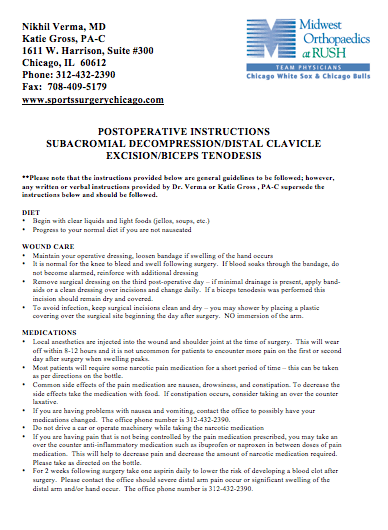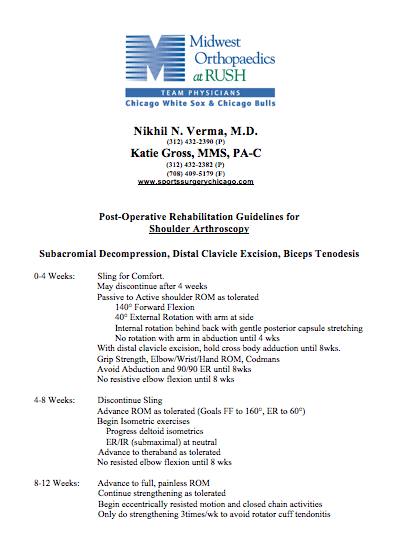Biceps Tenodesis
Are you an athlete who participates in sports that involve throwing overhead? If so, you may be at risk of developing an injury to the biceps. Biceps tenodesis surgeon, Dr. Nikhil Verma provides diagnosis and both surgical and nonsurgical treatment options for patients in Chicago who have sustained a biceps tendon injury. Contact Dr. Verma’s team today!
Biceps Tenodesis Overview
A common cause of pain and tenderness located on the front of the shoulder is biceps tendonitis. The biceps tendon is located on the arm between the shoulder and elbow and is responsible for elbow flexion and the ability to rotate the forearm. Athletes involved in overhead sports, such as basketball and swimming, are at an elevated risk of developing this condition. If biceps tendonitis causes extreme pain and shoulder disability without a response to non-surgical measures, biceps tenodesis or subpectoral biceps tenodesis may be the recommended surgical procedures. Chicago, Westchester, Oak Brook and Hinsdale, Illinois area orthopedic shoulder surgeon, Dr. Nikhil Verma is extremely well-trained and experienced at treating patients with severe shoulder pain and loss of function from biceps tendonitis.
Two muscle “bellies” compose the biceps, the long head of the biceps and the short head of the biceps. The long head of the biceps actually enters the shoulder joint and attaches to the top of the socket (glenoid). As a result, it must slide back and forth through a thin groove in the front of the shoulder during shoulder motion, which places the tendon at risk for inflammation or tearing. The long head of the biceps is more commonly injured as a result of wear and tear, leading to inflammation and pain, although ruptures can occur due to trauma. Biceps tendonitis is caused by overuse, microtrauma from repetitive movements and degenerative changes in the shoulder.
Dr. Verma may perform a biceps tenodesis or subpectoral biceps tenodesis if conservative measures such as the RICE (Rest, Ice, Compression and Elevation) method, physical therapy, injections and anti-inflammatory medications do not alleviate the pain.
Biceps Tenodesis
Biceps tenodesis is an arthroscopic shoulder surgery used to repair damage to the biceps tendon. During the procedure, Dr. Verma will release the tendon from its attachment site inside the shoulder joint and then reattach to the upper arm bone. The reattachment of the tendon allows it to be away from the shoulder so overhead activity can resume. The procedure is performed through small incisions near the front of the armpit and uses a camera and small surgical instruments to make the repairs, helping patients return to activities faster with less pain and less complications. By re-attaching the tendon, the function of the muscle can be preserved to avoid discomfort, cramping or cosmetic deformity.
Subpectoral Biceps Tenodesis
Dr. Verma may also recommend a subpectoral biceps tenodesis in the case of a complete long head of the biceps rupture or failed biceps tenodesis procedure. During this procedure, Dr. Verma will release the tendon arthroscopically at its attachment site and a small cosmetic incision in the armpit (subpectoral approach) is used to reattach the tendon to the bone near the inferior portion of the pectoralis muscle. A subpectoral biceps tenodesis maintains the biceps tendon length and tension in the majority of cases.
Recovery and Rehabilitation after Biceps Tenodesis
Patients who undergo biceps tenodesis or subpectoral biceps tenodesis can expect an exceptional surgical outcome in most cases. A rehabilitation program will be prescribed to regain strength and range of motion. Range of motion can typically begin shortly after surgery with a full recovery at approximately three months. Following post-operative and rehabilitation protocols will help ensure a full recovery.
Post-Op Instructions for Biceps Tenodesis
Rehabilitation Guidelines for Biceps Tenodesis
To learn more about biceps tenodesis and subpectoral biceps tenodesis, please contact the orthopedic office of Dr. Nikhil Verma, shoulder surgeon treating the Chicago, Westchester, Oak Brook and Hinsdale, Illinois communities.




